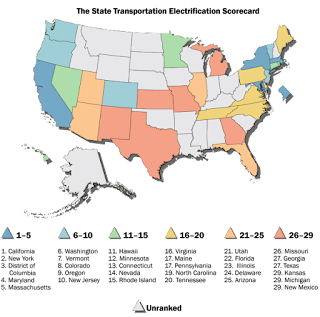Most of today’s electric vehicles (EVs) cause significantly fewer emissions overall than their gas-powered counterparts, and many have lower lifetime ownership costs, thanks to low fueling and maintenance expenses. But the higher initial purchase cost and lack of access to vehicle charging remain barriers for many households and fleet owners—obstacles some states are mitigating by offering incentives to buy EVs, adding more charging options, and setting lower electric rates at preferred charging times.
The State Transportation Electrification Scorecard finds that California is far and away the national leader in enabling the use of EVs. It is the only state to set deadlines for electrifying transit buses, heavy trucks, and commercial vehicles. The state is also one of few to offer assistance for lower-income drivers replacing older, high-polluting cars with zero- or near-zero-emissions vehicles, and it plans to deploy chargers in economically distressed and environmental justice communities.
California earned 91 of 100 possible points, followed by New York (63.5 points), Washington, DC (59), Maryland (56), Massachusetts (54.5), Washington (54), Vermont (54), Colorado (48), Oregon (47), and New Jersey (44). In contrast, 20 states earned 15 points or fewer.
While many states have taken promising steps to electrify transportation, all have considerable room to improve their policies. Ultimately, a full shift to affordable and accessible electrified vehicles—powered entirely by zero-carbon energy—will be necessary to bring emissions to zero and support livable communities.
“Transitioning to electric vehicles is vital for the climate and for reducing costs for households and businesses,” said Bryan Howard, state policy director at ACEEE and lead report author. “The leading states are embracing this transition, but many more are just starting, even as the automakers are preparing a burst of new electric models.”
Shruti Vaidyanathan, transportation program director at ACEEE and a fellow report author said, “State policymakers can make a concerted effort to enable an electric vehicle transition that not only reduces pollution, but also helps improve access to electrified transportation and quality of life for everyone. The transition won’t happen soon enough nor equitably without the right policies in place.”
The most common state actions to electrify transportation include planning for more EVs and EV charging options (23 states); incentives such as rebates, tax credits, and grants to buy large electric pickups and delivery trucks (27 states); using federal funds to buy electric transit buses (48 states); utility programs that offer lower electric rates at preferred times for EV (Level 2) charging (36 states); and utility funding to spur EV and EV charging adoption in low-income areas and environmental justice communities (15 states). These actions provide key examples of opportunities for other states that have not yet taken these steps.
The scorecard identifies commendable efforts in each region of the country, including the following:
New York was the second-highest ranking state and the top scorer in the Northeast. It has a strong set of incentives for individuals and fleet owners to purchase EVs, and the state and utilities incentivize installing charging infrastructure. The states’ utilities have also targeted more than one-quarter of the investment in their EV infrastructure program toward lower-socioeconomic and disadvantaged communities.
Washington, DC, ranked third. It is a leader in setting ambitious goals for the deployment of personal EVs, together with strong investment in electric transit buses, producing significant development of charging options.
Colorado earned the highest score in the Southwest; it has adopted a goal of having 940,000 EVs on its roadways by 2030. Lawmakers adopted incentives for EV charging investments and required utilities to file plans for EV charging infrastructure. Regulators recently approved a utility plan to install approximately 20,000 chargers throughout the state.
Minnesota was the top scorer in the Midwest (39.5 points). Regulators issued guidelines on utilities’ investment in charging stations, bringing $23.6 million in funding, with more proposed. The state has signaled its intent to adopt California’s zero-emissions vehicle (ZEV) program for personal vehicles.
Virginia performed best in the Southeast (36 points), with solid incentives for electric trucks and buses, time-varying electric rates for home and workplace chargers, and steps to decarbonize the electric grid.
“I’m thrilled that California is being recognized with top honors for our leadership efforts, especially at a time when Governor Newsom is doubling down on our commitment to ensuring all Californians can participate in the transition to clean transportation,” said California Energy Commissioner Patty Monahan. “Our experience shows transportation electrification is a win-win: good for the economy and most importantly for the health and well-being of those affected most by air pollution from tailpipe emissions.”
ACEEE identified three policies that are likely to have the greatest impact for spurring adoption of EVs: ZEV mandates and electric vehicle deployment targets, financial incentives for vehicle purchases, and incentives for installing vehicle chargers. The report scored the states on 40 policies in total, identifying where legislatures, executive agencies, and utility regulators in each state can make progress.

